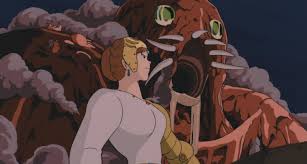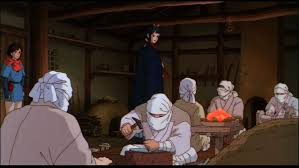Ms Formerly Aldgate has introduced me over the last two
years to the work of the Japanese animated production house Studio Ghibli and its
acclaimed output of quirky (Kiki’s Delivery Service), wacky (The Castle of Laputa), moving (The Wind Rises),
achingly sad (Grave of the Fireflies) or plain weird films (Ponyo). I had half
a mind, having watched Princess Mononoke (1997) some time ago, to post about
the most striking character in that movie (and arguably any of the others), and
having just completed Nausicaa of the Valley of the Winds (1984) that half-a-mind has
grown to a whole one. This is because of a clear resemblance between Lady
Eboshi of the first film, whose characterisation first caught my attention, and
Lady Kushana of the second, earlier animation.
Both movies dramatise the conflict between humanity and
nature, although Mononoke is set in medieval Japan and Nausicaa in an imaginary
future a millennium after the collapse of industrial society, and in many ways
the earlier film seems a dry run for the subtler, later one. Both Kushana and
Eboshi are strong women, military leaders of their respective social groups;
both stand on the side of human conquest of the natural world; both act as
antagonists to a pair of younger male and female heroes; both are extremely
beautiful where their female opponents are merely girlishly pretty. Both,
strangely, are mutilated; we discover that Kushana's left arm, clad in gold
armour, is prosthetic, and it’s strongly implied that her similarly armoured
legs are too; while Eboshi loses her right forearm towards the end of Princess
Mononoke.
 In Nausicaa, Kushana acts on behalf of
Tolmekia, a warlike kingdom which finds itself accidentally in conflict with
the peaceable Valley of the Winds, of which Nausicaa is Princess. Her mission is to prepare
and employ a Giant Fire Warrior, a living weapon whose use in the distant past
proved catastrophic to human society, to burn and cleanse the Sea of Decay, a
toxic jungle haunted by gigantic mutant insects whose gradual encroachment
threatens the remnants of humanity. In the later narrative, Lady Eboshi leads a
proto-industrial settlement called Irontown, whose citizens face destitution
unless they can exploit the iron reserves hidden beneath an adjoining forest;
this brings her into conflict with the creatures, both natural and magical, for
whom the ancient woods are home. The women are, therefore, on parallel missions.
Both are courageous and extremely brave; both show flashes of sardonic humour.
In Nausicaa, Kushana acts on behalf of
Tolmekia, a warlike kingdom which finds itself accidentally in conflict with
the peaceable Valley of the Winds, of which Nausicaa is Princess. Her mission is to prepare
and employ a Giant Fire Warrior, a living weapon whose use in the distant past
proved catastrophic to human society, to burn and cleanse the Sea of Decay, a
toxic jungle haunted by gigantic mutant insects whose gradual encroachment
threatens the remnants of humanity. In the later narrative, Lady Eboshi leads a
proto-industrial settlement called Irontown, whose citizens face destitution
unless they can exploit the iron reserves hidden beneath an adjoining forest;
this brings her into conflict with the creatures, both natural and magical, for
whom the ancient woods are home. The women are, therefore, on parallel missions.
Both are courageous and extremely brave; both show flashes of sardonic humour.
 This makes the divergence all the more striking. Kushana is
never more than a sketch for Eboshi just as Nausicaa is a rough outline for
Mononoke. Eboshi never exhibits Kushana's capacity for treachery or unnecessary
cruelty. Kushana is also simply incorrect; she remains unaware of the crucial
fact the film’s heroes, Nausicaa and Asbel, discover – that the Sea of Decay
rests on a petrified forest where the air and water are clean, and is thus
purifying the poisoned earth. Eboshi’s mission is more morally ambiguous, and is, very
interestingly, presented with such a variety of positive aspects that it
becomes very hard indeed to dislike her. Irontown is not merely an embryonic
techno-capitalist society juxtaposed with an older, natural way of living: it’s
a sanctuary for the damaged and marginalised and a place of social progress.
Eboshi has personally rescued considerable numbers of prostitutes, buying them
out of their contracts and taking them to Irontown to work in her factory. Another
group of workers are lepers who are not only employed but cared for: no wonder
they speak about her in glowing terms. In Irontown, men and women have
different work but equal status: they both defend the town side-by-side when
defence is required. Some reviewers characterise Eboshi as motivated by
‘greed’, but this is reading her domain wrong. The town is nothing less than an
alternative society, a vision of something better than 16th-century
Japan offered, unhampered by status and tradition. There is no doubt that
Eboshi would export her revolution if she got the chance, and the world might
not be a worse place for it. It’s not as though this is the last forest in
existence, or that the natural world cares anything for the welfare of the
humans who move across it: this is an era when people all too often have
to grub a living from an unyielding earth, facing starvation the next time a
harvest fails, and Eboshi’s vision, of human beings liberated and given their
true worth by work and progress, is, surely, worth a few trees.
This makes the divergence all the more striking. Kushana is
never more than a sketch for Eboshi just as Nausicaa is a rough outline for
Mononoke. Eboshi never exhibits Kushana's capacity for treachery or unnecessary
cruelty. Kushana is also simply incorrect; she remains unaware of the crucial
fact the film’s heroes, Nausicaa and Asbel, discover – that the Sea of Decay
rests on a petrified forest where the air and water are clean, and is thus
purifying the poisoned earth. Eboshi’s mission is more morally ambiguous, and is, very
interestingly, presented with such a variety of positive aspects that it
becomes very hard indeed to dislike her. Irontown is not merely an embryonic
techno-capitalist society juxtaposed with an older, natural way of living: it’s
a sanctuary for the damaged and marginalised and a place of social progress.
Eboshi has personally rescued considerable numbers of prostitutes, buying them
out of their contracts and taking them to Irontown to work in her factory. Another
group of workers are lepers who are not only employed but cared for: no wonder
they speak about her in glowing terms. In Irontown, men and women have
different work but equal status: they both defend the town side-by-side when
defence is required. Some reviewers characterise Eboshi as motivated by
‘greed’, but this is reading her domain wrong. The town is nothing less than an
alternative society, a vision of something better than 16th-century
Japan offered, unhampered by status and tradition. There is no doubt that
Eboshi would export her revolution if she got the chance, and the world might
not be a worse place for it. It’s not as though this is the last forest in
existence, or that the natural world cares anything for the welfare of the
humans who move across it: this is an era when people all too often have
to grub a living from an unyielding earth, facing starvation the next time a
harvest fails, and Eboshi’s vision, of human beings liberated and given their
true worth by work and progress, is, surely, worth a few trees.
 The only characters without a good word to say for the
dictator of Irontown are the heroes, the noble Ashitaka and the feral San. San
stands alongside the creatures of the forest, and no longer even thinks of herself as human; Ashitaka is being slowly poisoned
from a wound inflicted by a boar-god driven mad by an iron bullet forged, as it
turns out, in Eboshi’s own factory. Her people, on the other hand, not only
respect her – they love her. They adore her. She, for her part, is far from
starry-eyed about them; she is nevertheless utterly clear and focused about how
they can be helped, and about clearing whatever stands in the way, from trees
to neighbouring lords to gods. Hers is a ruthless compassion. She is the
embodiment of Enlightenment rationalism, as dismissive of the Emperor as she is
of the forest spirits. The fact that Studio Ghibli’s auteur Hayao Miyazaki,
with his environmentalist concerns, chooses to represent this ideology so
positively is remarkable.
The only characters without a good word to say for the
dictator of Irontown are the heroes, the noble Ashitaka and the feral San. San
stands alongside the creatures of the forest, and no longer even thinks of herself as human; Ashitaka is being slowly poisoned
from a wound inflicted by a boar-god driven mad by an iron bullet forged, as it
turns out, in Eboshi’s own factory. Her people, on the other hand, not only
respect her – they love her. They adore her. She, for her part, is far from
starry-eyed about them; she is nevertheless utterly clear and focused about how
they can be helped, and about clearing whatever stands in the way, from trees
to neighbouring lords to gods. Hers is a ruthless compassion. She is the
embodiment of Enlightenment rationalism, as dismissive of the Emperor as she is
of the forest spirits. The fact that Studio Ghibli’s auteur Hayao Miyazaki,
with his environmentalist concerns, chooses to represent this ideology so
positively is remarkable.
 Lady Eboshi finishes the movie humbled, recognising the
devastation unleashed by her foolhardy assault on the Forest Spirit, and promising
Ashitaka ‘we’ll build a better village’. She realises that the earth cannot
simply be conquered, and that ultimately human welfare relies on it. But her
vision remains intact: the devotion of her people is undimmed, her revolution
unabandoned. She remains a compelling image of an almost ideal leadership.
Lady Eboshi finishes the movie humbled, recognising the
devastation unleashed by her foolhardy assault on the Forest Spirit, and promising
Ashitaka ‘we’ll build a better village’. She realises that the earth cannot
simply be conquered, and that ultimately human welfare relies on it. But her
vision remains intact: the devotion of her people is undimmed, her revolution
unabandoned. She remains a compelling image of an almost ideal leadership.
I am not the first person to have written in praise of Lady Eboshi. Not at all. Certainly not. Far from it.

No comments:
Post a Comment